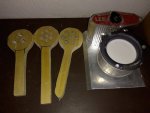I have been doing a fair bit of research on building a bench top annealing machine. There are plenty of DIY ways to do it and I had all the parts researched and decided on. Right before I was about to purchase them all on amazon I read about Salt bath annealing.
What are the pros and cons of Salt Bath annealing? It seems to be a heck of a lot cheaper ($35 smelting pot and less than $10 in salt etc vs many hundreds of dollars for a commercial Torch annealing machine) and easier. The only cons seem to be that you can not automate the insert and extract of the brass into the salt bath....there by giving up some consistency and accuracy.
Have any of you done both?
What are the pros and cons of each?
Why are more people not doing the Salt bath method?
What are the pros and cons of Salt Bath annealing? It seems to be a heck of a lot cheaper ($35 smelting pot and less than $10 in salt etc vs many hundreds of dollars for a commercial Torch annealing machine) and easier. The only cons seem to be that you can not automate the insert and extract of the brass into the salt bath....there by giving up some consistency and accuracy.
Have any of you done both?
What are the pros and cons of each?
Why are more people not doing the Salt bath method?


